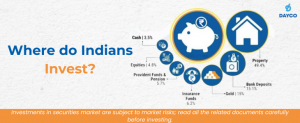How Much Percentage of Indian Population Invest In Stocks
![]() April 20, 2024
April 20, 2024
![]() 0 Comments
0 Comments
India’s story is the story of growth. Businesses across the country are riding on innovation, technology and demographic dividend to grow big. And where businesses thrive, stock market investors thrive as well. The number of Indian stock market investors has been abysmal for decades. However this is changing now. The percentage of Indian investors investing in stocks has been increasing steadily.
Total Number of Indian Stock Market Investors
Thanks to the popularity of smartphone-based investment apps, India has been witnessing a steady surge in the number of stock market investors. According to a report published in Business Today, as of January 2024, India has around 87 million investors as opposed to 17.9 million in 2015. The Indian state of Maharashtra has the most percentage share of stock market investors 17.4% of stock market investors come from Maharashtra making it the top in this regard. From the perspective of households, 17% of the total Indian households invest in the stock market.
How Much Percentage of Indians Invest In The Stock Market?
Despite a rise in the number of people investing in the stock market, the percentage of Indians investing in stocks stood at around 3% as of 2023. This is both good and bad news. The good news is that there is enough room for growth for the India equity market. And the bad news is the fact that many Indians still remain averse to investing. Comparing this with other countries, 13% of the Chinese population invest in the stock market and in the USA, that figure is a whopping 55%
In a recent report by Jefferies, it's clear that Indian households have a strong preference for things they can touch and feel, like real estate and gold, rather than abstract financial assets like insurance and mutual funds.
The report reveals that out of a whopping INR 917.341 lakh crore in household assets as of March 2023, a huge 66% is tied up in physical assets like gold and real estate. Real estate takes the lion's share, accounting up to 51%, while gold holds a respectable 15%. When it comes to financial assets, bank deposits are the most popular, making up 14% of the total household assets. Insurance and pension funds each make up 6%.
Interestingly, only 5% of Indian households' wealth is invested in stocks, suggesting a cautious approach to the ups and downs of the market. And they keep about 3% of their assets in cash for emergencies. Overall, the report highlights how Indian families tend to favor tangible investments while being careful with their financial choices.
Mutual Funds to The Rescue
People in India are generally risk averse when it comes to financial markets. This is where mutual funds come in. Mutual funds can shoulder a significant amount of know-how and processes for investors. An investor can leverage the expertise of mutual fund managers to invest in equities in an indirect way.
The mutual fund industry too has grown a lot during the past decade. In 2014, the AUM of the Indian mutual fund industry stood at around Rs. 8.25 trillion. In 2024, it stands at around Rs. 53.40 trillion.
Bottomline
In India, tangible investment assets are favoured more than intangible ones.
Although the percentage of Indians investing in stocks may be low, as a country and its GDP grow, there is a gradual shift from traditional asset classes. This is also evident from the way the mutual fund AUM has grown in a matter of 10 years. The coming decade will be the decade of India’s stock market growth story.
~Nischay Avichal
Share With
I'm a cool paragraph that lives inside of an even cooler modal. Wins!
Are you sure?
In case you didnt know, you can open your account online within 24 hours. Offline account opening takes up to 4 working days. If you wish to open your account offline, fill and sign the forms using a black/blue ballpoint pen. Please fill in the email and mobile number of the applicant to avoid account opening delays.
Enter Password
Please enter your details and password
New to Dayco?
Enter Password
Please enter your details and password
New to Dayco?
Filing Complaints on SCORES (SEBI) – Easy & Quick
- Register on SCORES Portal (SEBI)
- Mandatory details for filing complaints on SCORES:
- Name, PAN, Address, Mobile Number, E-mail ID
- Benifits:
- Effective Communication
- Speedy redressal of the grievances
Thanks !!
Your details were successfully received.

Thank you for Your Feedback!
Our Team is working constantly on improving our user experience and your feedback really means a lot.
Thanks !!
App Link Send to your mobile number successfully.
Thank You
All your Questions have been recorded
Thank You
All your Questions have been recorded
Thank You!
Thank you for your response. We'll get in touch with you at the earlisest for your investment planning needs
NEXT
Thank You!
Thank You for your interest in our Moderate Equity Portfolio. Please find below the credentials to track this portfolio:
User ID: mockmod@daycoindia.com
Password: abcd@1234
Portfolio Tracker
Please Read!
Risk profiling is crucial for identifying and managing potential risks in investment decisions. Please carry out your risk profiling before making any investment decisions.
Complete Risk Assessment Now
Thank You !!
Please enter your details to download/print the report
Thank You !!
Please enter your details to download/print the report
Thank You !!
Please enter your details to download/print the report
Thank You !!
Please enter your details to download/print the report
Thank You !!
Please enter your details to download/print the report
Set Your Goal
Please Select an option from below
Set Your Goal
Please Select an option from below
Thanks You !
We appreciate your interest in our services. Our team will be in touch with you shortly.
CloseSet your Goal
Please enter your details in the fields provided
Thanks You!!
Calculation report has been sent to your mail id successfully
Clear form?
This will remove your answers from all questions and cannot be undone.



 Book Appointment
Book Appointment









Leave a Reply